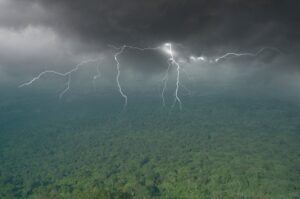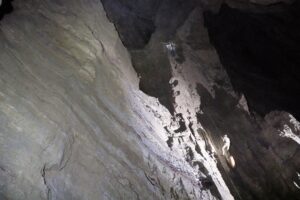The volcanic Cappadocia region in Turkey is a sculpture garden of deep valleys, caves, tunnels, and odd-looking pillars called fairy chimneys. While they look man-made, they are the result of millions of years of tectonic movement and erosion.

Fairy chimneys in Cappadocia. Photo: Julia Volk/Pexels
In the Paleogene Period, which began 66 million years ago, the African, Indian, Arabian, and Eurasian tectonic plates collided. The resulting volcanic eruptions formed Turkey. Ash littered the landscape and condensed into tuff, a porous, soft, and malleable rock.
Eventually, this convenient raw material allowed the region’s inhabitants to carve houses, monasteries, hiding spaces, and even tunnels within the rock. The area housed persecuted Christians during Roman rule, from small cave dwellings to long tunnel networks that could fit thousands underground.
Additional weathering and erosion created pointy, cone-shaped formations and thin columns stretching over 40m tall. These are the hoodoos or fairy chimneys. They are made of tuff, tuffite, and ash. The minerals in these rocks give them different colors.
The highly porous rock absorbs rainwater, which travels through the holes and cracks inside. This causes the basalt to wear away and leaves the harder layer behind. This usually takes on the form of a pointed or mushroom-shaped cap. This hard basalt is called ignimbrite. Over time, the rest of the column continues to wear away and crumble. The cap, however, remains.

Love Valley. Photo: Shutterstock
Sword Valley, Love Valley
There are over 30 different valleys, including the Valley of Imagination. Here, the rock formations resemble animals like birds and even people like Napoleon Bonaparte. The Rose Valley contains rocks that seem to turn pink at sunset.
Many fairy chimneys in Kiliclar Valley, also called Sword Valley, are thin like swords. Love Valley has the most well-defined and thicker chimneys which look rather phallic. Hence the name. Ironically, these same chimneys acted as small chapels and whole churches, with stairs and windows built into them.

Mushroom caps on fairy chimneys. Photo: Tolga Ahmetler/Unsplash
Fairy chimneys are not endemic just to Turkey. They exist all over the world. In the United States, you can find them mostly in New Mexico and Utah’s quintessential red canyons. Chimneys also exist in Madagascar, Canada, Serbia, France, and Armenia.

Fairy chimneys, Turkey. Photo: Shutterstock






